Tight fixation is necessary for various injuries and diseases of the joints to relieve the load from the diseased focus and speedy recovery. For fixed fixation of the ankle is used. Bandaging can be done with an elastic or regular gauze bandage, and also use pharmacy orthoses and bandages for this.
In what cases is 8-shaped bandaging used?
The bandage can be therapeutic and prophylactic. People who stand on their feet all day, lift weights, go in for professional sports (gymnastics, weightlifting, cycling) apply a bandage for preventive purposes.
Therapeutic bandaging is used in the following situations:
Arthritis or arthrosis of the ankle - with inflammation, pain occurs, the activity of the joint changes. With arthritis of the ankle joint, the pain syndrome fetters the limb in the morning, after prolonged exertion, foot deformity is possible. Tight bandage takes off pain, reduces the risk of complications and relapses, returns mobility;
Bruises, sprains- with bruises, it is painful for the patient to step on the foot, swelling and hematoma appear, which limit the mobility of the ankles. When stretched, the pain is sharp, swelling occurs, it hurts to move the leg. A pressure bandage on the ankle relieves pain, does not allow the leg to move, swelling and cyanosis of the leg pass faster; 
Ankle muscle tear- with a partial rupture of the ligaments, a pronounced edema appears, which covers most of the foot, movement in the paw is difficult, pain occurs even at rest. Together with the lesion, blood accumulates, a hematoma forms, the mobility of the ankle is difficult. With a complete rupture of the ligaments, the foot becomes immobile, any movement becomes impossible. Local blood supply is disturbed, hemorrhage under the skin captures the entire foot, including the ankle and sole;
Dislocations and subluxations- with a complete dislocation, the surfaces of the joint are displaced, sharp pain pierces the entire foot, the foot is unable to move, swelling appears, blood accumulates in the joint cavity, cyanosis occurs;
Fracture of ankle bones- in case of a fracture with a complete rupture of the ligaments or displacement of the joints of the foot, it is recommended surgical intervention, after which the patient is put in a cast for three weeks. After the fusion of bones for rehabilitation, the patient is recommended to wear a special splint or an elastic 8-shaped bandage.
Video
Video - Applying an eight-shaped bandage to the lower leg
Basic rules for bandaging
There are several different types of dressings that are used for various conditions. For bandaging the ankle, an eight-shaped overlay is used, the bandage is also called cruciform or spike-shaped.
In order for bandaging to be beneficial, to be effective, to help in the treatment and prevention of diseases, the application of an eight-shaped bandage on ankle joint must be accompanied by certain rules:
- If there is a wound on the surface, it is treated;
- When the joint is deformed, its protrusion, the application of an extensible bandage is contraindicated, it is necessary to contact the emergency room;
- The bandage is not applied after a long walk, you need to rest for at least half an hour, it is best to bandage after a night's sleep to relieve possible swelling;
- In order not to overdo it and avoid pulling the joint, an extensible or gauze bandage is placed on the toe. Too tight bandaging disrupts blood circulation in the tissues;
- The bandage should be applied evenly, make sure that there are no folds and gaps;
- The overlay procedure is carried out by gradually unwinding the bandage; it is not necessary to immediately unwind the entire roll;
- At rest, at home, at night, the tight bandage is removed, the leg can be massaged to improve blood circulation;
- The bandage should be tight, but if half an hour after bandaging the ankle becomes numb, there is a pulsation or a tingling sensation, then the bandage is too tight. In this case, the bandage is removed and the leg is allowed to rest.
AT the best option the sequence of application should be shown to the patient by a medical worker, as well as the first few procedures should be done independently.
Execution technique
In case of an ankle injury, a person should be taken to the hospital as soon as possible. medical institution. Injuries are different and without an examination by a specialist it is not always possible to determine what kind of bandage is needed.
It is possible to independently apply an extensible or gauze bandage in unforeseen cases to provide first aid to the victim, when it is not possible to deliver the patient to a medical facility. It is important to make sure that there is no fracture or dislocation, in which case the refusal of medical care is a danger to human health.
The algorithm for applying a bandage is as follows: 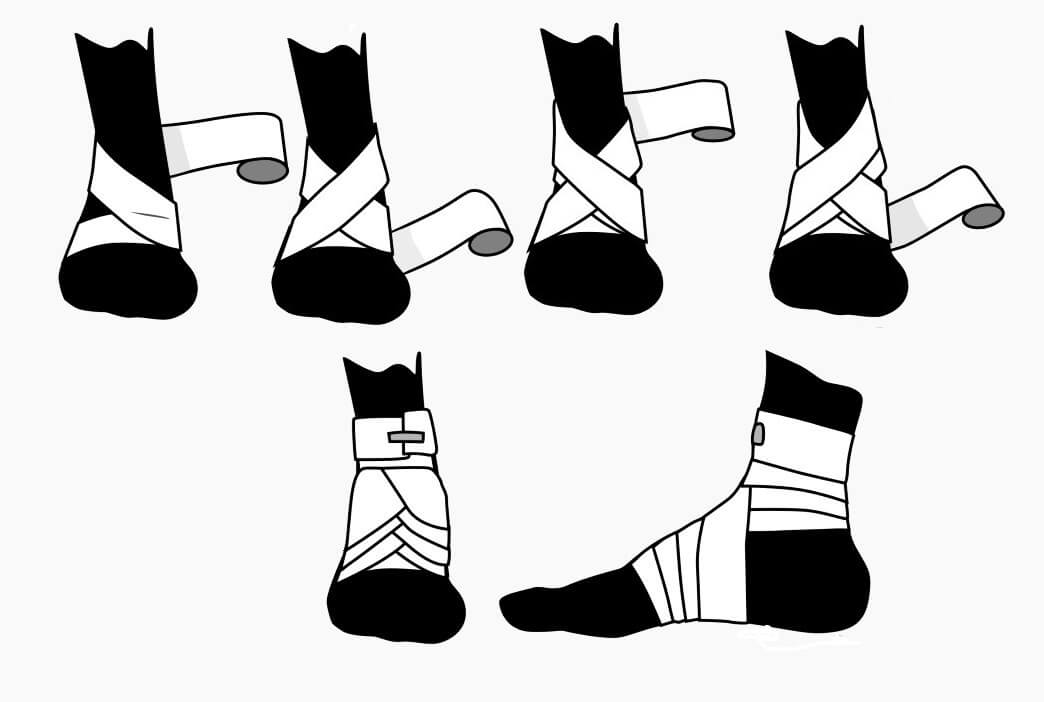
The bandage reduces the load on the affected area, fixes the joint at a right angle, helps to reduce pain and swelling, and the limb is immobilized. If the bandage was applied correctly and accurately, then the damaged joint will quickly restore its functions and return to normal.
As a result of injury to the ankle, doctors recommend the use of a brace. After all, the fixing bandage on the ankle is used for mild degree ankle fracture and ligament injury. In addition to fixators, it is possible to use an elastic bandage, especially when.
For people who constantly experience heavy loads on the ankle, the use of a soft fixing bandage is recommended. It can be applied independently, the main thing is to adhere to the correct technique for fixing it.
Rules for the use of a fixing bandage on the ankle
Fixation dressings are used to reduce the degree of stress on the damaged area and speed up the recovery process after injury.
Athletes whose work activity is associated with frequent bruises and injuries should have fixing bandages at hand. Elderly people need fixing bandages to ensure the safety of the ankle joint.
The fixing bandage on the ankle is considered an essential remedy for various kinds of injuries and bruises. In case of damage to the ankle, first of all, try to ensure that the leg is fixed in a secure position and the load on this area is minimal. Depending on the degree of injury, the dressings differ from each other.
Fastener types
The most reliable and more optimal form of fixation is the eight-shaped bandage on the ankle joint. Usually it is applied only by a specialist, because there are special rules for its application, improper dressing can contribute to harm to the health of the victim.
Learning to properly fix the ankle
A fixing bandage is applied to the ankle according to certain rules, which must be strictly followed. If the bandage is applied incorrectly or it is tight, then this can provoke the development of complications. To fix the ankle, you will need a fixing bandage and clamps. Place the victim on a flat surface, his leg on your knees. Usually this bandage is applied in emergency situations. Try not to move the victim, thereby ensuring the correct application of the bandage.
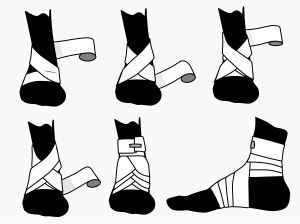
There are situations that the leg is injured on the road or where there are no conditions for seeking medical help. Therefore, it is necessary to adhere to some features for proper fixation of the ankle:
- To eliminate the discomfort of the victim and in order not to overtighten the leg, it is better to put an elastic bandage on the sock. After all, if the ankle is pulled with a bandage, blood flow to it will be difficult, which will significantly worsen the condition of the victim.
- If the victim has open wound, then the bandage on the ankle is not applied. And you need to get him to the hospital as soon as possible. Cover the wound with a sterile dressing to prevent infection.
- If there is heavy bleeding, then it is necessary to apply a tourniquet, cover the wound with a sterile bandage and seek medical help. An elastic bandage is applied when there is no visible damage to the ankle.
- If the victim has noticeable displacements in the ankle joint, then the bandage is not applied. A cold compress is applied to the bruised area and urgently called ambulance.
It is necessary to ensure that the victim lies, does not stand on a sore leg, and even more so walks, as this can provoke minor injuries and undesirable consequences. It is important to know that in case of damage to the ankle joint, only a doctor can provide the correct medical care and choose a bandage for fixation.
Ankle Taping Rules
It is worth saying a few words about taping, teips are such elastic patches that are applied over the skin surface and are additionally held by a bandage applied in a certain way. This method is widely used among athletes and active people to prevent joint injuries, as well as to rehabilitate previously damaged ones. Before you start taping, you need to prepare the necessary materials:
- Elastic bandage or sports tape;
- A taping pad is a material that is applied before taping;
- Cushioning pads under the foot and heel;
- Petrolatum.
Before taping, you need to make sure that the ankle area is dry, clean and undamaged. The foot must be placed at a 90 degree angle. It is best if the patient lies on a flat surface.
Taping must be carried out strictly according to the instructions, the observance of which is mandatory:
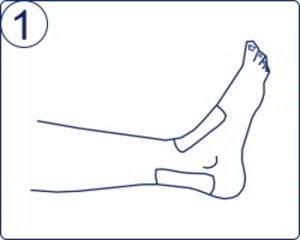 | A thin layer of petroleum jelly is applied to the area of the instep of the foot, and 2 shock-absorbing pads are applied |
 | The pads are applied in such a way that the entire damaged area of the ankle joint is closed. |
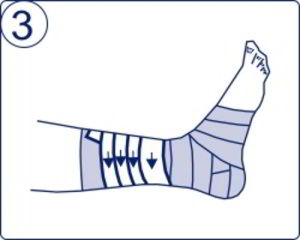 | With three or four strips of tape, make turns around the lower leg. It is important to know that any strip of teip should cover the other, not less than half, overlapping (overlapping) |
 | The next three strips are superimposed on the ankle in the form of a stirrup, overlapping the previous bandage |
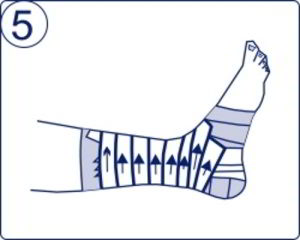 | To apply the next row, 7-8 strips will be required. They are superimposed, starting from the top of the bandage, moving towards the foot and thereby closing the stirrup. Try to cover the previous dressings halfway. The strips are overlapped, and the row ends on the lateral surface of the foot. The stripes don't overlap here. |
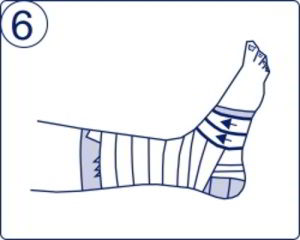 | In the area of the instep of the foot, another 2-3 strips are applied. Taping is not done too tight |
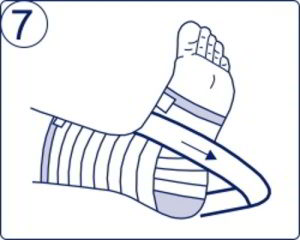 | On the instep of the foot, fasten the tape and lead across the foot to the sole, bring it under the heel. Make sure that there are no folds on the tape. Next, trace the tape around the heel and fasten the strip on the side of the ankle from which you started in the instep area. Strip off the roll |
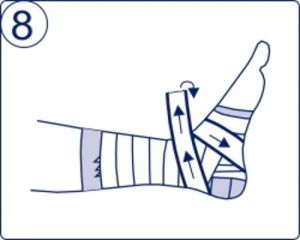 | In the final we fix the heel. Without removing the tape from the roll, we fix it on the instep of the foot. The tape is applied across the foot and after passing the sole, it starts behind the heel |
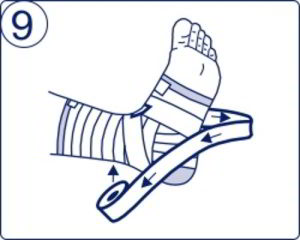 | Make sure that the tape is applied evenly, without creases and folds. |
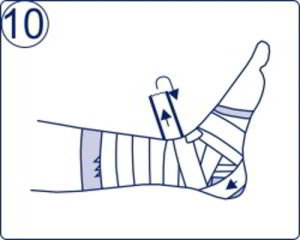 | The tape should end on the instep of the foot, only after that it should be torn off the roll. |
 | Taping completed |
In conclusion, I would like to say that almost everyone is concerned about joint problems. And here the main thing is to notice in time and prevent the disease from developing further.
Bandages are applied to the joints if it is necessary to fix the bone joints in case of injuries (bruises, sprains) or pain syndrome (arthralgia) of a different origin. are more common than other injuries. In some cases, it is the bandage that is the first aid to the victim.
Help with ankle injury
Applying a bandage requires following the correct sequence of actions. Ideally, the manipulation should be performed by a health worker. But in extreme or field conditions, a specialist is often not around. Therefore, for any person it will not be superfluous to know the main features of applying bandages for injuries, as well as other methods of first aid. used for bruises or sprains of the ligamentous apparatus. So you can protect the limb from new injuries and significantly reduce pain in the joint.
Using a bandage on the ankle joint, it is possible to limit the movement of the foot
And through this to achieve several positive effects:
- prevent further tissue damage in the joint area;
- reduce the load on the joint;
- reduce the intensity of pain, reduce swelling, activate local blood circulation and metabolic processes;
- create a compression effect, which eliminates the divergence of damaged structures and accelerates tissue healing;
- accelerate the recovery process of the joint after injury.
Materials used for bandaging
If necessary, first aid dressings can serve as different kinds bandages (elastic, gauze, linen, flannel) or just strips of fabric. For a bandage, it is best to use an elastic bandage. In its absence, an ordinary gauze bandage 10–15 cm wide is also suitable. The following equipment may be needed for manipulation: tweezers, scissors, a tray, special clips for an elastic bandage.
In sports practice, to fix the joint, they often use a special adhesive tape - a sports tape. Exists different types teips, differing in elasticity and adhesiveness. The taping process requires certain skills, knowledge of various techniques, allowing you to create an individual highly effective bandage for the joint. When applying a teip bandage, a special porous material called a teip pad is placed under the adhesive tape.
A special place is occupied by orthopedic products for the ankle joints, in particular, bandages and fixators. They are designed specifically for this part of the body. They can be used for treatment and recovery, as well as for the prevention of damage to articular structures during intense exercise. Special orthoses for joints have also been developed, which have complex design and capable of almost completely eliminating movement in the ankle.
Video
Video - Ankle bandage
Dressing rules
There are some general rules to follow when applying bandages. The injured person should take a comfortable position. The bandaged part of the body must be fixed in a functionally advantageous position. The dressing material should not tighten the limb too much and interfere with the blood supply to the tissues. Nevertheless, a tight bandage is required to ensure reliable fixation of the joint. 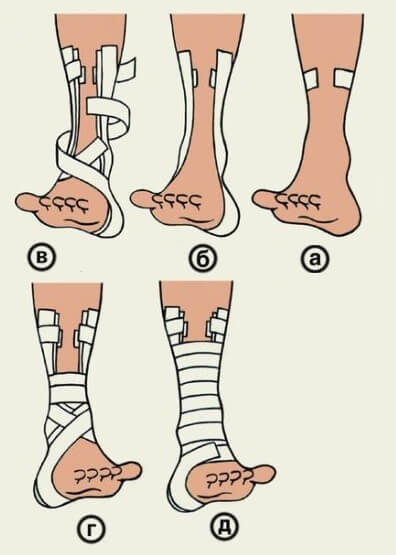
The tours of the bandage are applied in such a way as to cover the surface of the bandaged area as much as possible, making sure that there are no kinks in the bands. Each subsequent move of the bandage is applied so that it is 2-3 cm on the underlying layer. Fixing rounds at the beginning and end of the procedure are made in the narrow part of the lower leg. The roll with dressing material is untwisted gradually as the limb is bandaged.
The elastic bandage is slightly pulled when applying the bandage. This results in a more secure hold. For the same purpose, the gauze bandage is sometimes moistened before manipulation: when it dries, the bandage on the ankle joint becomes denser. But you should always remember that the injured person should not experience discomfort or inconvenience. If the leg is bandaged too tightly, tingling, numbness, or throbbing occurs after 20 minutes. Discomfort means that the dressing is not applied correctly and needs to be redone.
If the bandage is applied daily, it is better to do this after a night's sleep or rest. when there is no swelling of the tissues, and it is possible to better fix the joint. The elastic bandage is needed only during movement, it should be removed at rest. After removing the joint retainer, it is recommended to massage to improve local blood circulation.
The sequence of actions when applying a bandage
A cruciform (eight-shaped) bandage is usually applied to the ankle joint. Its name is due to the direction of the bandage tours, crossed in the form of a figure eight and covering not only the joint, but also lower part shins and feet. When applying a bandage, the leg is carefully placed on a stand, chair or roller, in the field on one's knees. The limb should be opposite the lower sections chest bandaging. In this case, the foot must be positioned freely. The joint is fixed in the position of flexion at a right angle.
The sequence of applying bandage tours:
- fasten the bandage on the lower leg, making 2-3 turns around the area above the ankles;
- direct the next course of the bandage along the back surface to the outer edge of the left foot or the inner right;
- wrap the bandage around the sole and remove the bandage from the lateral edge of the foot along the back surfaces of the foot and joint towards the opposite ankle;
- making a cross over the previous strip of bandage, direct a new round around the lower leg for a fixing turn;
- for reliable fixation of the joint, repeat bandaging 5-6 times, following the same sequence of rounds;
- finish the bandage by applying fixing tours in the lower third of the lower leg, cut the bandage and tie a knot.
Indications and contraindications for dressing
Ankle bandage can be used in different situations, but most often they resort to this remedy for injuries. The most common type of joint injury is a sprain. The injury develops with a sudden twisting of the foot. With a simple sprain, you need to apply a bandage and leave it for 4-5 days. Rupture of ligaments requires more serious measures. For up to 10 days, a plaster splint is applied. Then they switch to fixing the joint with a figure-of-eight plaster cast for another 2 weeks.
You can distinguish between sprain and rupture of ligaments by the symptoms of injury. Sprain is accompanied by pain, which soon subsides for a couple of hours. Then the pain intensifies again, swelling increases, movements are limited due to pain. A ligament rupture is characterized by a sharp intense pain, swelling, hemorrhage in the ankle area, a complete absence of active movements in the ankle.
There are other indications for applying an ankle bandage:
- severe pain syndrome with inflammatory joint damage, with osteoarthritis and other systemic diseases of the connective tissue;
- bruises with intense pain in the joint area;
- recovery period after reduction;
- prevention of injury during intense exercise.
If there is an open wound in the joint area, a noticeable deformity, bleeding, then bandaging the leg should be discarded. The wound surface is covered with a sterile napkin. In the presence of displacement, apply cold to the injured area, provide rest for the limb. With severe bleeding, a tourniquet is applied. In any of these situations, the victim must be urgently taken to a medical facility for qualified assistance.
There are also relative contraindications for applying a bandage. These include skin diseases, the risk of thrombosis, impaired local circulation. If they are present in an emergency, a bandage can be applied for a short time, while it is needed.
Bandaging technique is very important. Therefore, it is better to entrust the procedure to a specialist. The potential benefit of a bandage may be less significant than the harm from inept manipulation. Therefore, foot binding should be resorted to only if there is confidence in the need for the procedure, certain knowledge and skills in this area.
You can not resort to self-medication. For example, attempting to treat a dislocation with tight bandaging can lead to serious problems. If the reposition is not done in a timely manner, open surgical reduction will be required, difficult treatment and a long recovery period.
An elastic bandage for the ankle joint is a medical accessory that is prescribed to the patient in case of injuries.
Advantages
The elastic bandage for the ankle joint has a number of advantages, among which are the following:
- long period of use. It can be reused many times and is not easily deformed;
- tight and secure fit. The bandage does not slip, so it does not need to be re-bandaged;
- versatility. Suitable for absolutely any joint;
- does not require special training for use;
- ease of use (easy to remove);
- economy.
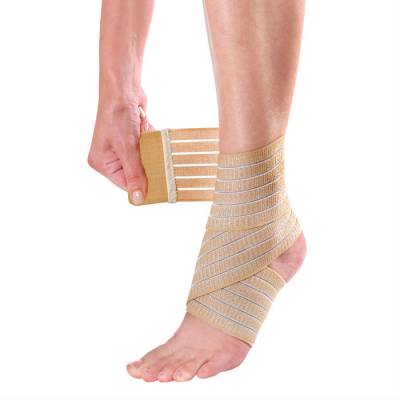
An elastic bandage will replace about twenty ordinary gauze bandages, so this is a rational and profitable approach to business.
Flaws
Any device has its drawbacks, elastic bandage is no exception. Let's consider the main ones:
- improper imposition leads to impaired blood circulation;
- incorrect bandaging can poorly fix to the joint;
- the device will deteriorate ahead of time in case of poor care;
- you need to have certain skills and abilities.
Indications for use
The ankle joint needs to be immobilized in some situations:
- with sprain or rupture of ligaments;
- after injury;
- during inflammation of the joint, which is accompanied by swelling;
- as a preventive measure during intense physical activity.
Doctors advise to always have an elastic bandage in your first aid kit, especially for people involved in vigorous physical activity.
Mistakes
Let's talk about reliable signs of incorrect overlay technique:
- if the bandaging is too tight, the venous outflow is disturbed, as a result of which the fingertips turn blue;
- tight fixation disrupts arterial inflow, as a result of which the fingers become pale and cold;
- due to weak bandaging, the ankle will not be sufficiently fixed.
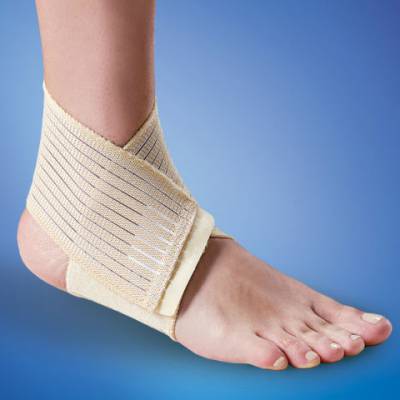
In order to improve blood circulation in the joint, it is necessary to remove the bandage at least a couple of times.
The bandage should be washed once a week, but in no case should it be twisted, otherwise it will lose its elasticity.
pressure bandage
Let's talk about the rules of imposition:
- overlay is carried out clockwise, starting from the ball of the foot. The bandage must be pulled evenly, and it should not be pre-reeled;
- turns the whole foot. It is wrong to bandage with one hand, both hands should participate in the process, since one should hold the beginning of the bandage. The threads must be in the same direction. The bandage should fit, but not press;
- ankle wrap. Bandaging is carried out in an eight-way;
- repetition of eight-shaped turns;
- securing the end of the bandage.
The bandage must be neat. The duration of wearing can be determined by a specialist, but as a rule, it is one to two hours.
Sports tape
Dressing with a sports tape is carried out as follows:
- first wrapped lengthwise top part feet;
- then you need to fix crosswise from the foot to the ankle;
- triple eight-shaped winding.
The elastic bandage does not harm the skin, as it is made from natural fabrics.
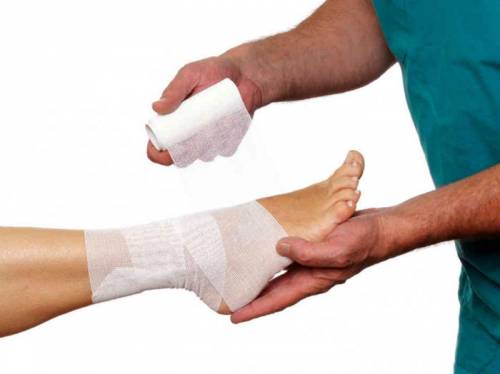
The patient should not feel tingling or numbness. If these feelings arise, it is necessary to replace the fixation
Tapes are called elastic plasters applied to skin. They must be additionally held by a specially applied bandage.
Before taping, prepare the following materials:
- elastic bandage (tape is an alternative);
- podteipnik (this is the material that is applied under the patch);
- linings that are applied directly under the foot;
- petrolatum.
It is important to make sure that the ankle is dry, clean and undamaged. During the procedure, the patient should lie quietly on his back.
Having prepared all the necessary materials, you can start taping:
- first of all, a thin layer of petroleum jelly is applied;
- two cushion pads are applied in such a way that the entire damaged part is covered;
- turns are made around the lower leg with the help of several strips of teip. Each strip should cover the previous one by about half;
- the previous dressing is overlapped by the following strips, which are superimposed in the form of a stirrup;
- starting from top to bottom, the stirrup is covered with the following strips;
- on the very rise of the foot, a few more strips are superimposed;
- the tape is fixed and fixed on the heel evenly, without wrinkles or flaws;
- the instep of the foot is the place where the tape should end.
Fixing bandage - instructions for use
Fixing dressings reduce the degree of stress on the place that has been damaged, and also accelerate the processes of regeneration (recovery).
People involved in sports often get bruises and injuries, which is why a fixing bandage is simply necessary.
A fixing bandage is a kind of "ambulance" or first aid for injuries.
The most reliable and optimal form of fixation is the eight-shaped bandage. It must be applied with skill, otherwise it will be harmful to health, so a specialist in his field should deal with it.
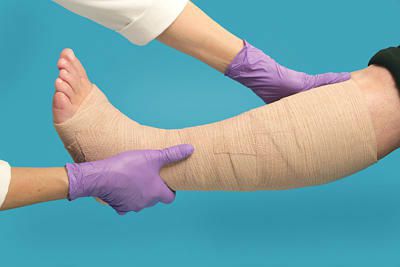
With the help of an elastic bandage, the cast can be removed every day, so that the injured joint will be well developed.
- the bandage should be applied in the morning, while the limbs are still swollen;
- after bandaging, it is better to lie down, and place your legs above your head;
- when applying a bandage, folds should not form;
- to avoid squeezing soft tissues, the bandage unwinds outward;
- gaps should not form between turns of the bandage;
- the bandage should be used during active movement, it can be removed at rest;
- dressing begins and ends at a remote distance from the site of the lesion;
- Separately, I would like to mention the extensibility of elastic bandages.
Medium and high degree of extensibility will contribute to reliable fixation of the limbs after traumatization. In order to prevent varicose veins after surgical interventions on the limbs it is necessary to use low-elastic bandages.
Summing up all of the above, I would like to say that absolutely no one is immune from joint problems. Do not despair, and at the slightest injury, seek the help of specialists, and before that, make a bandage with an elastic bandage.
